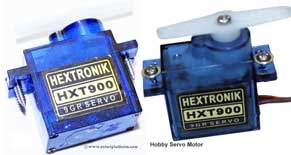Hobby Servo Motor Tutorial
We all know what an electric motor is, and also about a DC motor. One type of DC motor is a  Servo Motor. Servo Motor is a device which uses error-sensing feedback signals to determine and control the position of a motor shaft. The term “servomechanism” closely relates to servo motors which refer to any device that uses error-sensing feedback to correct the performance of a system.
Servo Motor. Servo Motor is a device which uses error-sensing feedback signals to determine and control the position of a motor shaft. The term “servomechanism” closely relates to servo motors which refer to any device that uses error-sensing feedback to correct the performance of a system.
This tutorial will cover the following concepts related to Servo motors:
- Introduction to Servos
- Inside a Servo
- Major Servo Manufacturers
- What makes a Servo
- Servo Control tutorial
- Servo Principle
- Servo Control using a Microcontroller
- Servo Control with 555 IC
- Modifying a Servo
- Servo FAQ
Introduction to Servos
There are different types of servo motors available in the market depending on their size, type of input current (AC or DC), brush or brushless, torque, voltage rating, rotation limit (90°, 120°, 180°) etc. For a robot builder, all that matters is a cheap, mass-produced servo motor that runs on a battery, generally known as RC Servo’s. (Since these servos are generally used in radio controlled models and applications, they are generally known as RC servos).
The purpose of this tutorial is to provide information necessary to understand the construction, basic operation and control of a radio controlled (RC) or hobby type servo motor. If you are looking for information on other large AC servo motors, or industrial servo motors then you may please look elsewhere for information (No, I am not telling you to go; but just that this page contains more interesting information than the one you are looking for… :)
Hereafter, the term “Servo” refers to these small servo motors (RC servos, Hobby servos …) used in most RC cars, small mobile robots, helicopters’ etc.
Servo motor has gained a lot of popularity in the robot community due to its simplicity, ease of use, availability, and affordability. Almost all RC planes, helicopters, RC Cars, and of course most mobile robots has a servo built inside. One of the biggest advantages of servo over other DC motors is the ease of control. It does not require complicated external circuitry, or an external H-bridge. It has all the circuitry built in to control the angle, direction and speed of the DC motor.
Do you have anything to say?
Visit the Forum to discuss, learn and share anything related to robotics and electronics !!








